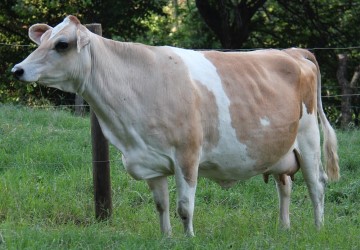By DERRICK FRIGOT

This article appeared in the very first issue of RURAL in the spring of 2013. Derrick at the time (he has since retired) was the president of the World Jersey Cattle Bureau. Following his return from a Bureau visit to South America in 2012, he reported on the advantages of keeping the Jersey breed in the variety of South American landscapes… ‘’neath Palm and Pine’
DURING a visit of the World Jersey Cattle Bureau to Colombia, I found Jersey cows grazing above 10,000 feet high in the mountains. Jerseys are crossed with Holsteins to improve milk quality, health, and fertility and feed conversion. In hot and humid lowlands, Jerseys are crossed with Bos Indicus cattle – Brahmin, Sahiwal, Gujarat, Gir and other breeds to raise production and profit. All demonstrate the versatile ability of the Jersey to perform in a variety of environments and topography.

The visit to Guatemala and Colombia by members of the World Jersey Cattle Bureau in June 2912 demonstrated why the Jersey is gaining popularity in Latin America. The Jersey business is buoyant in all countries on the South American continent and live animals are being imported into some of the countries such as the Dominican Republic, Panama, Venezuela, Guyana, Suriname, Nicaragua where very few, if any, Jersey cattle had been farmed in the past.
These cattle are arriving from countries like Guatemala and Colombia, and also Costa Rica, Argentina, Uruguay and Brazil, where the Jersey has been an established dairy breed for generations.
In Colombia, the government has altered the pricing of milk which is now based on total solids, fat and protein, and the price is as much as 25% more for Jersey milk against Holstein milk. This has really changed the thinking of dairymen and a measure of the swing to the Jersey breed is that in 1995, less than 5,000 doses of semen were imported, but in 2011, over 65,000 doses were imported.
Demand for Jerseys is high and not too many easily available, and the price of in-calf heifers is at an all-time high of between USD 4,000 to USD 6,000 (£2,500 – £4,000).
The scene in Guatemala is similar with an annual growth in Jerseys at just under 10% – more than all the other breeds. Crossbreeding is gaining popularity, especially with the Bos Indicus breeds in the humid lowlands. Two milk payment systems exist, but payment per solids and fat is more common.
The WJCB visit to Guatemala and Colombia included more than 20 herd visits, demonstrating the resourceful ways the breeders have utilised the breed, either in its pure state, or crossed with other breeds to suit the environment.

Some of the herds were all-Jersey that had been established for some time – others included some black and whites that were mostly being crossed with Jersey to advance to a virtual all-Jersey herd. In the challenging tropical coastal lowlands, using the Jersey to improve production, fertility and health of indigenous Bos Indicus cattle was extremely interesting.
The herd at the Hacienda Furatena owned by Alejandro Gomez is a long-time established pedigree Black and White Holstein and Red and White Holstein one. The estate milks 320 cows and following a visit to New Zealand 12 years ago, the decision was made to cross with Jersey. Today, about 25% of the herd is Jersey x Holstein and this is increasing.
Alejandro Gomez commented: ‘The Jersey crossbreds have proven to be “as good or better” than their Holstein herdmates by thriving and excelling in reproductive and productive traits on a low-input pasture-based operation.’
Clearly with their reproductive efficiencies and their economical production of milk components, they have contributed to the profitability and competitiveness of Furatena’s low-input milking operation and have helped position the farm favorably with regards to the growing globalized milk market that lies ahead.
An interesting observation was the use of many internationally recognised and popular sires in their crossbreeding programme. The FI’s are not criss-crossed with either of the original breeds but with another FI crossbred, thus establishing a ‘composite’ breed to suit the local conditions.
A visit to Ganaderia San Rafael demonstrated the use of the Jersey across Bos Indicus cattle. The day included a sale of beef and crossbred cattle with many local farmers attending, as well as an in-vitrio demonstration with vets collecting embryos from Brahmin and Gujarat cows to be fertilised with Jersey semen.
During the sale, a number of Jersey crosses out of various Bos Indicus cows were offered and they made above-average prices. The advantage of the cross was the instant increase in milk production, better fertility and health traits while retaining the immunity to tropical heat and disease – something that is being recognised by the breeders of Colombia.
There is no doubt that the Jersey breed is playing an increasing part in the dairy industry in Latin America. Farmers are recognising the advantages of the breed and are making fast progress in converting to the efficient, economical, quality-producing Jersey.





